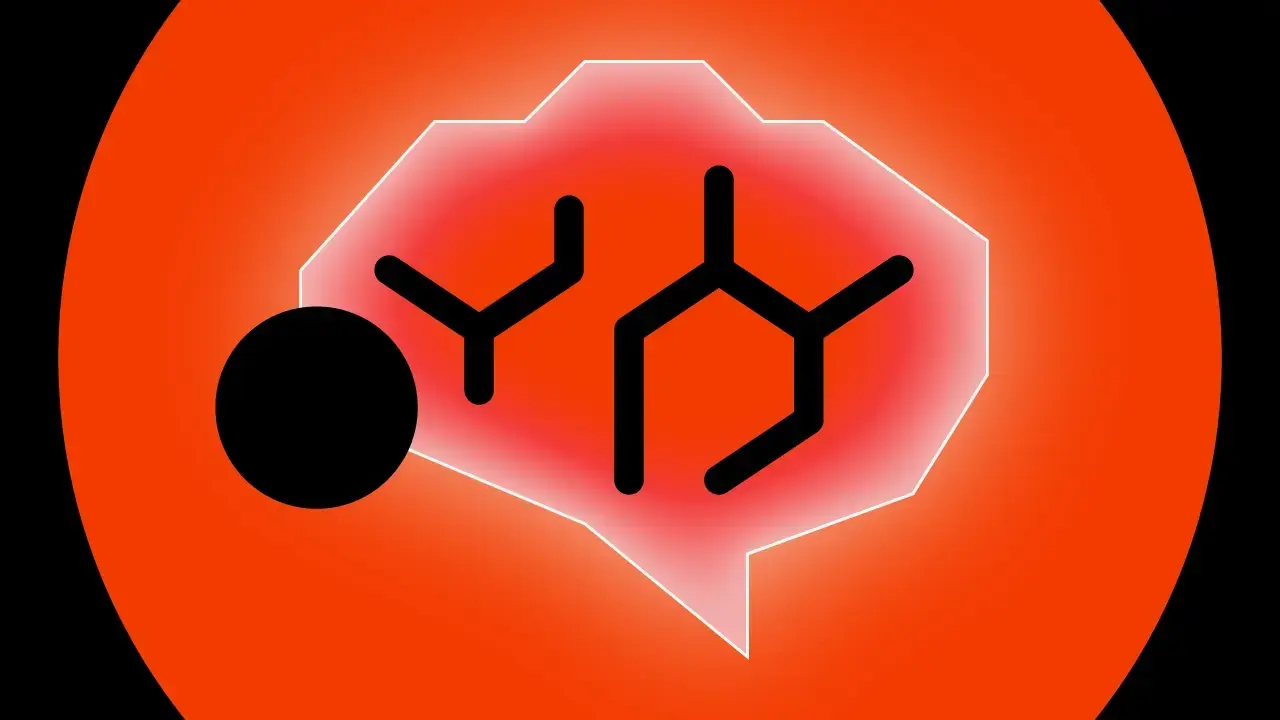Managing patchwork projects in software development

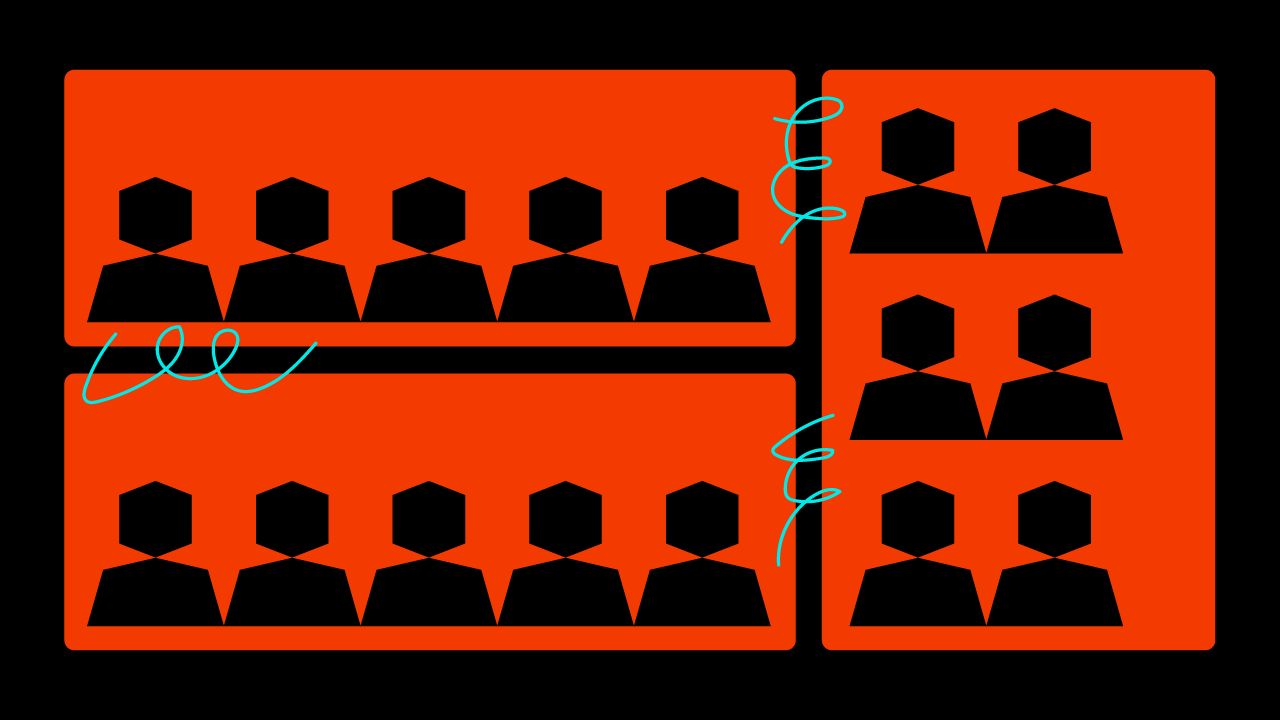
Today’s technology world often relies on complex systems. In these systems, software creation is no longer the work of a single company. Projects carried out by many organisations at the same time are becoming more popular, creating new challenges for development teams.
Understanding these “patchwork projects” and learning how to manage them is key to success. Companies are increasingly using specialised services from outside suppliers. This helps them access unique skills or reduce costs.
This article suggests that managing patchwork software projects well needs more than old methods. It requires actively shaping and managing the entire group of cooperating organisations. This is different from just coordinating individual teams.
Table of contents
Understanding patchwork projects in software development
The term “patchwork project” describes software projects involving many separate, often independent, organisations or units. These different groups must work closely together. Their shared goal is to deliver a working and valuable digital product.
This type of cooperation is like sewing different pieces of material into one whole. It offers great potential. However, it also carries certain risks.
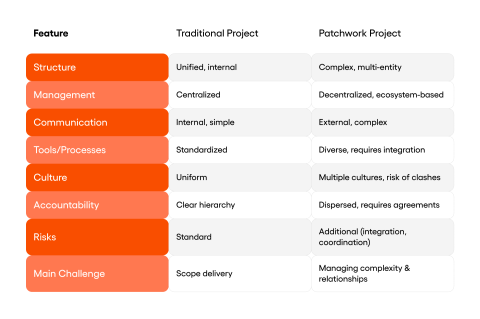
Definition of the concept
A patchwork project in software development means different parts of the project are handled by separate, specialised groups. This includes not only the main client but also various development service providers, consultants, or external specialists. The aim is for their efforts to combine effectively, creating a consistent and functional solution.
Typical participants in such a project system include the main client, who defines the product’s vision and goals. External developers or entire development teams are responsible for specific modules or layers of the application. Security auditors, UX/UI agencies focusing on user experience, and cloud or hosting infrastructure providers are also often involved.
Each of these groups adds unique value. Yet, each also introduces an extra layer of complexity to the project.
Main characteristics
Patchwork projects have several distinct features that directly affect how they are managed. Teams are often spread out geographically, working in different time zones. This frequently leads to varied approaches to IT project development.
This diversity results in many organisational cultures existing side by side. Each culture has its own norms, values, and working styles. Conflicting priorities can also arise, where the goals of individual companies, such as maximising profit from a contract, may clash with the main project objectives.
The technological landscape can be very varied. Different teams might use different tools, technologies, or work methods. A complex group of stakeholders, with many people influencing the project, and complicated inter-organisational dependencies further complicate management.
Typical scenarios
Patchwork projects appear in various forms, depending on business and technological needs. One common scenario is system integration. Here, the client’s old systems, often called legacy systems, must work with new modules created by external suppliers.
Such integration requires careful planning and precise coordination. Another example involves projects that need very specialised knowledge. We also see the outsourcing of specific software development phases.
These phases can include testing, creating the user interface (frontend), or developing business logic (backend). Sometimes, joint technology ventures between two or more companies, combining forces to implement an application, also take the form of a patchwork project.
Inherent complexities
The nature of patchwork projects means they come with certain challenges. These challenges must be actively watched and managed. Key difficulties include the formation of communication silos, which hinder the flow of information.
Coordination difficulties, problems from inconsistent development tools and processes, and potential cultural clashes are other significant challenges. Importantly, unclear responsibility for specific components or business processes can lead to decision-making paralysis. It can also lead to mutual blaming if problems occur.
It is clear that the points where teams connect carry the greatest risk. Effectively managing a patchwork project largely involves effectively managing these connection points.

In-depth analysis: challenges and pitfalls
Poor management of patchwork projects can lead to delays and budget overruns. It can even cause the entire project to fail. Understanding these problem areas is the first step to effectively avoiding them.
It is also worth remembering that some of these issues worsen with remote work. Remote work has become standard for many distributed teams.
Communication barriers
Information silos, where knowledge and key information stay within one organisation or team, are a fundamental barrier. This situation leads to a lack of transparency. Differences in communication methods, preferred channels, or even language barriers, even if everyone speaks English, can further deepen this issue.
Often, a top-down tendency is observed for communication to occur mainly along formal contractual lines. This means information is passed only “through management” instead of directly between technical teams. This leads to information gaps and delays, as direct contact between specialists is limited.
Coordination obstacles
Each company tends to optimise its own resources. This is not always aligned with the main project goal. Complex dependencies between tasks carried out by different teams require precise synchronisation, which is hard to achieve without centralised coordination.
Difficulties in synchronising sprints, release plans, or general work schedules are common. This is especially true when teams operate on different calendars, have different work paces, or use different methodologies. Reliance on effective communication is critical here; a lack of knowledge about other teams’ progress, problems, or planned changes prevents effective synchronisation and leads to inefficiency.
Mismatch of tools and processes
For example, different workspaces in Jira, a project management tool, make it hard to track tasks across the entire project. Similarly, different version control systems, like Git or SVN which manage code changes, complicate code integration. Moreover, such mismatches generate extra costs related to data conversion or manual information transfer.
Differences in coding standards, technical documentation requirements, or test and development environment configurations significantly increase the work involved in manual integration. This not only results in delays but also increases the risk of errors. It can also lead to hidden software quality problems.
Cultural and organisational differences
Cultural and organisational differences between companies are often underestimated. However, they are an extremely important source of problems. These include different work ethics, varied approaches to hierarchy, and different customs for meetings or giving feedback.
These subtle, “soft” aspects greatly influence daily interactions. The consequences of these differences can be misunderstandings and growing distrust between teams. Frustration from different expectations and generally lower cooperation efficiency can also result.
Ignoring these cultural aspects is a common mistake in managing patchwork projects.
Responsibility gaps
Unclear responsibility for key project areas is a ticking time bomb. Integration points between systems created by different teams are particularly problematic. Shared software components and tasks that naturally require multiple parties’ involvement also pose challenges.
If problems occur where different teams’ skills overlap, there is a risk of a “blame culture”. This means no one feels responsible. Difficulty in defining end-to-end responsibility for entire business processes that cross module or system boundaries is another challenge.
A lack of clearly assigned roles and responsibilities becomes a source of conflict, delays, and quality gaps. For instance, it might be unclear who is ultimately responsible for a feature from the user interface to the database. This, in turn, can lead to disputes about who should bear the costs of repairs or further development.
Conflict of interest and competition management
In patchwork projects involving many companies, conflicts can naturally arise. Each supplier may aim to maximise their scope of work. Sometimes this happens at the expense of other entities, which can lead to unhealthy competition.
Conflicting priorities, where the long-term project goal gives way to short-term contractual benefits for individual companies, are a significant threat in this context. As people managing a patchwork project, we should also protect against situations where suppliers “poach” key employees from each other. This could destabilise teams and the entire project.
Developing strategies to balance the interests of different entities becomes crucial. Implementing transparent mechanisms for resolving disputes that may arise from these conflicts is also important. Clearly defined rules for cooperation and problem escalation are essential here.
Interconnection of challenges
All the mentioned challenges are closely linked. They often reinforce each other, creating a complex network of problems. For example, poor communication inevitably deepens coordination problems, as teams lack sufficient information to synchronise their actions.
In turn, a mismatch of tools and processes can generate frustration and misunderstandings. These issues can then worsen cultural differences. Cultural and organisational differences often underlie many other problems, affecting communication style, approach to responsibility, or openness to cooperation.
Understanding these interdependencies is key. It shows that these problems cannot be solved in isolation. A holistic approach to managing a patchwork project, considering all these aspects simultaneously, is needed.
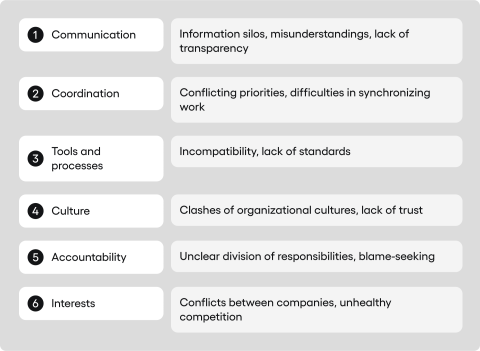
Best practices for effective management
Despite numerous challenges, patchwork projects can be carried out effectively. They can bring significant benefits. The key is to implement appropriate structures, processes, and tools, as well as consciously build a culture of cooperation.
Below, we present a set of best practices. These practices help prevent potential conflicts from erupting.
Governance, roles, and responsibilities
Establishing clear governance is fundamental to success in patchwork projects. This might include setting up an integrated Project Management Office (PMO). A PMO acts as a central point for coordination and oversight.
Steering committees composed of representatives from key stakeholders can also be part of governance. Clearly defined decision-making processes and problem escalation paths are also essential. Defining roles and responsibilities is particularly important for tasks assigned to several organisations.
One useful tool is the RACI matrix (Responsible, Accountable, Consulted, Informed). It specifies who is responsible for completing a task, who bears ultimate responsibility, who needs to be consulted, and who just needs to be informed. The goal is to build shared responsibility for the project’s success and promote a partnership model where all parties show appropriate commitment.
Communication and collaboration frameworks
Creating a formal communication plan is essential for ensuring an effective flow of information. It should specify who communicates, what is communicated, and when (how often). The plan also needs to detail which channels are used (e.g., email, dedicated messengers, meetings) and what tools will support this process.
Establishing common tools is key. Examples include Jira for task management, Confluence for documentation, or Slack/Microsoft Teams for daily communication. These tools become the “single source of truth” for all project participants.
Standardising progress, risk, and problem reporting using common templates and metrics facilitates mutual understanding and situation assessment. Regular, well-prepared meetings, such as daily stand-ups, weekly status meetings, or quarterly strategic reviews, are crucial for maintaining synchronisation. The aim of these actions is to increase shared understanding of goals and challenges, build transparency, and strengthen mutual trust between teams and organisations.
This is particularly important in remote work. Here, balancing synchronous and asynchronous communication is necessary.
Standardising tools and processes, and integration technologies
Striving to standardise key tools and processes is a strategy that can significantly reduce friction and inefficiency. In this context, automation plays a crucial role. This ranges from automatic tests and CI/CD (Continuous Integration/Continuous Delivery) processes, which automate software building and deployment, to automating infrastructure management tasks.
Static code analysis tools help maintain code quality and consistency. They detect potential errors and non-compliance with standards even before the integration stage. Tools that enforce a uniform coding style, such as Prettier or ESLint, ensure that code delivered by different teams is readable and easier to maintain.
Increasingly, organisations are also implementing internal tools based on artificial intelligence (AI). These are like “Copilots” that support developers in writing code, generating documentation, or identifying potential problems. This can significantly speed up work and improve its quality in complex project ecosystems.
Where full standardisation is not possible or reasonable, integration of existing systems should be pursued. This can be done using appropriate APIs (Application Programming Interfaces, which allow different software to communicate) or intermediary platforms. Common development, testing, and production environments minimise the risk of problems arising from configuration differences.
Adapting agile methodologies to the specifics of multi-team projects is often crucial. Agile methodologies are approaches to project management that emphasise flexibility and collaboration. Frameworks like Scrum of Scrums, used to coordinate multiple Scrum teams, help synchronise work.
Shared, integrated product backlogs and regular, joint planning sessions also contribute to synchronisation. It is also necessary to develop a common Definition of Done. This clearly defines the acceptance criteria for delivered functionalities, including code standards, testing processes, and security requirements.
It is also worth paying attention to technologies specifically designed for integrating distributed teams and systems. Integration Platforms as a Service (iPaaS) can automate the flow of data and processes between different applications used by individual entities. In the context of DevOps, a set of practices that combines software development and IT operations, solutions enabling CI/CD pipeline integration between different companies become key.
This ensures consistency in software building, testing, and deployment processes across the entire project ecosystem.
The potential of artificial intelligence and automation in managing complex project ecosystems
In managing patchwork projects, the potential of artificial intelligence (AI) and advanced automation opens new possibilities. AI can support decision-making by analysing large amounts of project data. It can identify patterns, predict potential risks, or optimise resource allocation.
AI-based systems can automate reporting processes and progress monitoring. They might even enable early detection of communication problems between teams by analysing interactions. Automation, going beyond the previously mentioned CI/CD or tests, can also cover configuration management, resource scaling, or even proactive incident management.
Using these technologies can significantly lighten the load on management teams. This allows them to focus on strategic aspects of cooperation and solving more complex interpersonal problems, which are an inherent part of patchwork projects. Integrating AI tools with project management platforms can create intelligent support systems.
These systems can help navigate the complicated environment of multiple suppliers and stakeholders. They aim to minimise risk and maximise the efficiency of the entire ecosystem.
Aspects of remote and hybrid work
Patchwork projects very often involve remote or hybrid work. This generates additional challenges but also opportunities. Conscious communication management becomes key, balancing the needs for synchronous interactions like live meetings and workshops with the efficiency of asynchronous communication such as documentation, tasks, and comments.
Teams must be provided with appropriate tools for effective remote collaboration. These include video conferencing platforms, shared virtual whiteboards like Miro or Mural, and advanced documentation management systems. Particular attention should be paid to meetings in a hybrid environment.
The goal is to ensure equal engagement from those working remotely and those present in the office. It is worth spending more time refining the agenda for each meeting here. Engaging moderators with appropriate soft skills can also be beneficial.
Moreover, regular virtual “coffee meetings” or other informal activities can help build relationships and trust in distributed teams.
Agile methodologies
For large patchwork projects involving many development teams, using scaled agile methodologies is often necessary. Examples include SAFe (Scaled Agile Framework), LeSS (Large-Scale Scrum), or Nexus. These allow for effective coordination of many agile teams working together on one product.
However, implementing these frameworks requires careful preparation. They must be adapted to the specifics of the project and the organisations involved. Providing appropriate training for all participants is crucial.
Using these methodologies can significantly improve predictability, quality, and efficiency in complex multi-team projects.
Legal barriers
Properly drafted contracts are essential to protect the interests of all parties. They also ensure smooth cooperation. Key elements of agreements should include precisely defined Service Level Agreements (SLAs).
Rules regarding intellectual property (IP) rights for the created software are also important. Procedures for managing project changes and clear definitions of responsibility for specific aspects must be included. Issues of data security, confidentiality, and exit clauses, for cases where cooperation needs to end, should also be regulated.
Contracts should be treated not just as legal documents. They are an integral part of the project’s operational model. Close cooperation between legal teams and project teams is important, starting from the agreement preparation stage.
This ensures their consistency with project goals and realities. Clearly defined terms of cooperation minimise the risk of future misunderstandings and disputes.
Building a “one team” culture
Despite the formal division into different organisations, building a sense of belonging to one, common project team is crucial. A joint project kick-off, where goals, vision, and expectations are clearly communicated, can significantly help with integration. Promoting direct interactions between members of different teams strengthens relationships and trust.
This can be done by organising joint workshop sessions, informal meetings (even virtual ones), or celebrating achieved milestones together. It is also necessary to establish transparent conflict resolution mechanisms. Conflicts will inevitably arise in such a complex environment, whether we like it or not.
The rules should be known to all participants. They should enable quick and constructive addressing of problems. Building psychological safety, where team members feel free to report potential problems without fear of negative consequences, is fundamental to effective cooperation.
Financial management and cost allocation
Effective financial management in patchwork projects requires special attention. Developing transparent billing models between companies is necessary. These may include hourly rates, fixed prices for specific scopes of work, or models based on risk and profit sharing.
It is crucial to determine which financial information should be transparent to all partners. Some information may need to remain confidential within individual organisations. Mechanisms for sharing financial risk should also be implemented.
This could be through joint budgets for unforeseen expenses or contractual clauses regulating responsibility for cost overruns. Analysing and minimising transaction costs related to inter-organisational cooperation is important. These include costs of coordination, system integration, or contract management.
This will help maintain financial control over the project.
Security first and foremost
Information and system security become particularly critical in patchwork projects. Many companies and their employees have access to shared resources, source code, and data. A thorough analysis of threats related to multiple access points and potential security gaps at system and organisational interfaces is necessary.
Uniform security standards must be defined and implemented for all project participants. These include secure coding practices, vulnerability management, data encryption, and protection against malicious software. Regular security audits, conducted by independent specialists, can help identify and eliminate vulnerable points.
Implementing a robust Identity and Access Management (IAM) strategy is key. This ensures that only authorised individuals have access to specific resources, based on the principle of least privilege. Each partner must be responsible for adhering to established security policies.
Regulatory compliance and data management
Patchwork projects, especially those with an international scope or operating in sectors like finance or healthcare, must meet numerous legal and regulatory requirements. An analysis of differences in compliance requirements between various countries is needed. For example, GDPR in the EU versus CCPA in California, as well as industry-specific regulations.
It is crucial to establish who is responsible for ensuring compliance when integrating multiple systems and processing data by different entities. Particular attention should be paid here to the personal data management strategy. This includes determining the roles of data controller and data processors.
Agreements between parties should specify data processing rules, security measures, and procedures for handling data breach incidents. Ensuring regulatory compliance is not only a legal obligation. It also builds trust with clients and partners.
Measuring success and Key Performance Indicators (KPIs)
Defining appropriate metrics and Key Performance Indicators (KPIs) is essential. Success metrics should be multi-dimensional. They should cover not only traditional aspects like timeliness, budget, and quality, but also indicators specific to such projects regarding the efficiency of inter-team integration.
For example, we can measure the time needed to integrate components from different suppliers. The number of errors at system interfaces or team satisfaction with cooperation can also be measured. KPIs for inter-organisational communication efficiency are also crucial.
These include the frequency and quality of interactions, the speed of resolving problems reported by other teams, or the level of understanding of common goals. In the context of work distributed among different teams, it is worth developing methods for measuring the effectiveness of this form of cooperation. This can be done through engagement surveys, analysis of collaboration tool usage, or productivity assessment.
Regular monitoring of these indicators allows for early detection of problems and taking corrective actions.
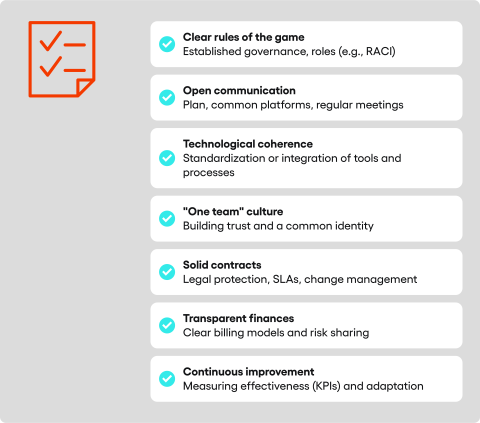
Key conclusions
Effective management of patchwork projects in software development is a complex and extremely important task. Success in such ventures mainly depends on how challenges, which will inevitably appear at some point, are handled.
It is therefore worth implementing a well-thought-out communication strategy. Key processes and tools should be standardised, and well-structured agreements ensured. Importantly, resources should be invested in building a common culture based on trust and partnership.
The growing importance of artificial intelligence and automation cannot be ignored either. These offer powerful tools for optimising the management of such complex undertakings.
The main message from analysing patchwork projects is the need for a change in perspective. It is no longer enough to manage individual teams or suppliers in isolation.
A systemic approach must be adopted. All participants should be treated as part of a single, dynamic ecosystem whose success depends on the harmonious cooperation of all its elements. Managing a patchwork project is therefore the art of managing relationships and minimising the risk of conflicts.
Clearly defined roles, transparent processes, and appropriate tools, including AI-based ones, are important. A strong culture of cooperation enables the effective use of synergy arising from combining diverse competencies and experiences. The ultimate goal is not just to deliver the product on time and within budget.
It is also to create a valuable solution that meets users’ needs and benefits all parties involved.
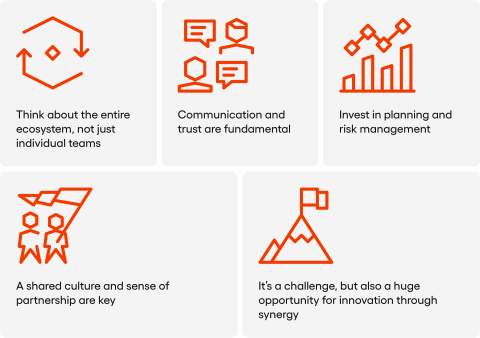
This blog post was created by our team of experts specialising in AI Governance, Web Development, Mobile Development, Technical Consultancy, and Digital Product Design. Our goal is to provide educational value and insights without marketing intent.




